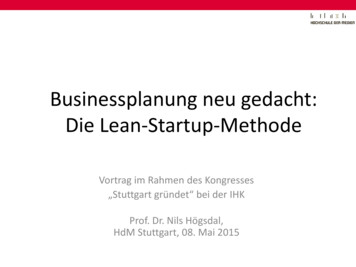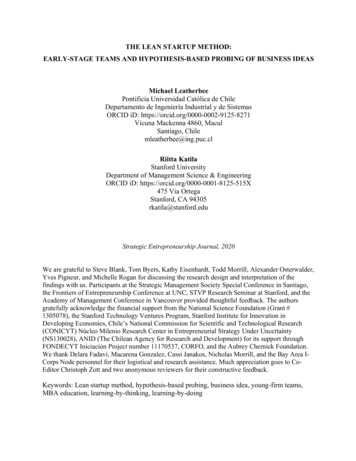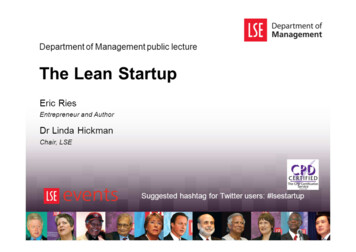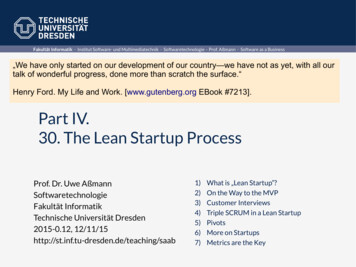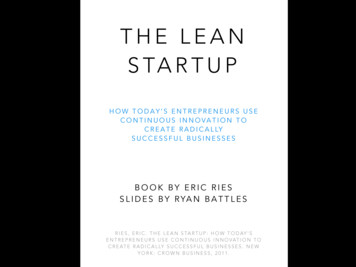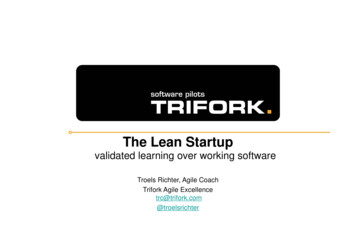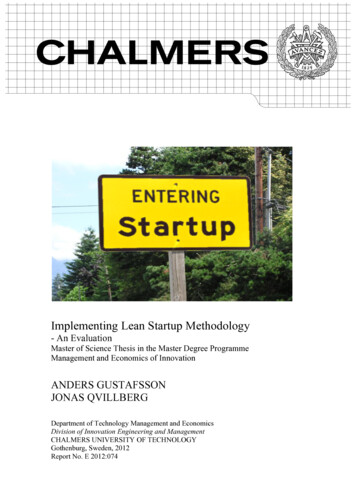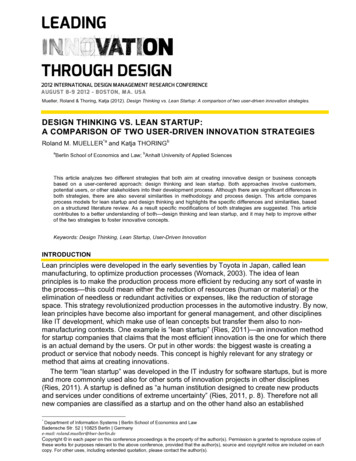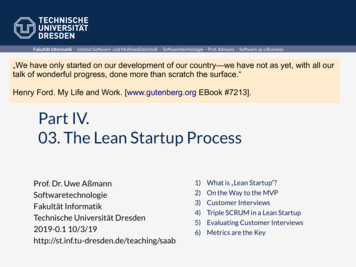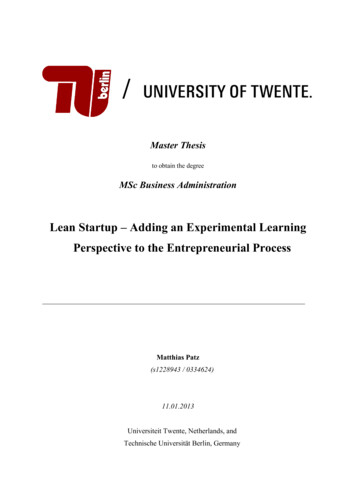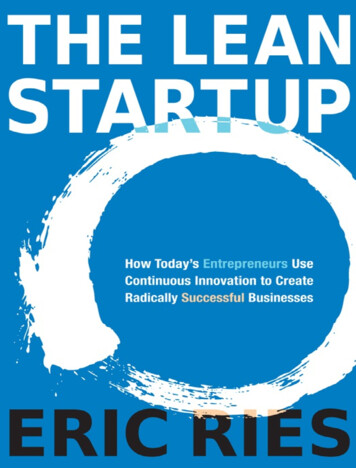
Transcription
Acclaim for THE LEAN STARTUP
Acclaim for THE LEAN STARTUP“The Lean Startup isn’t just about how to create a more successfulentrepreneurial business; it’s about what we can learn from thosebusinesses to improve virtually everything we do. I imagine LeanStartup principles applied to government programs, to health care,and to solving the world’s great problems. It’s ultimately an answerto the question How can we learn more quickly what works anddiscard what doesn’t?”—Tim O’Reilly, CEO, O’Reilly Media“Eric Ries unravels the mysteries of entrepreneurship and revealsthat magic and genius are not the necessary ingredients for successbut instead proposes a scienti c process that can be learned andreplicated. Whether you are a startup entrepreneur or corporateentrepreneur, there are important lessons here for you on yourquest toward the new and unknown.”—Tim Brown, CEO, IDEO“The road map for innovation for the twenty-first century. The ideasin The Lean Startup will help create the next industrial revolution.”—Steve Blank, lecturer, Stanford University,UC Berkeley Hass Business School“Every founding team should stop for forty-eight hours and readThe Lean Startup. Seriously, stop and read this book now.”—Scott Case, CEO, Startup America Partnership“The key lesson of this book is that startups happen in the present—that messy place between the past and the future where nothinghappens according to PowerPoint. Ries’s ‘read and react’ approachto this sport, his relentless focus on validated learning, the neverending anxiety of hovering between ‘persevere’ and ‘pivot,’ all bearwitness to his appreciation for the dynamics of entrepreneurship.”
—Geoffrey Moore, author, Crossing the Chasm“If you are an entrepreneur, read this book. If you are thinkingabout becoming an entrepreneur, read this book. If you are justcurious about entrepreneurship, read this book. Starting Lean istoday’s best practice for innovators. Do yourself a favor and readthis book.”—Randy Komisar, founding director of TiVo and author of thebestselling The Monk and the Riddle“How do you apply the fty-year-old ideas of Lean to the fastpaced, high-uncertainty world of startups? This book provides abrilliant, well-documented, and practical answer. It is sure tobecome a management classic.”—Don Reinertsen, author, The Principles of Product DevelopmentFlow“What would happen if businesses were built from the ground upto learn what their customers really wanted? The Lean Startup isthe foundation for reimagining almost everything about how workworks. Don’t let the word startup in the title confuse you. This is acookbook for entrepreneurs in organizations of all sizes.”—Roy Bahat, president, IGN Entertainment“The Lean Startup is a foundational must-read for founders,enabling them to reduce product failures by bringing structure andscience to what is usually informal and an art. It providesactionable ways to avoid product-learning mistakes, rigorouslyevaluate early signals from the market through validated learning,and decide whether to persevere or to pivot, all challenges thatheighten the chance of entrepreneurial failure.”—Noam Wasserman, professor, Harvard Business School“One of the best and most insightful new books onentrepreneurship and management I’ve ever read. Should be
entrepreneurship and management I’ve ever read. Should berequired reading not only for the entrepreneurs that I work with,but for my friends and colleagues in various industries who haveinevitably grappled with many of the challenges that The LeanStartup addresses.”—Eugene J. Huang, partner, True North Venture Partner“In business, a ‘lean’ enterprise is sustainable e ciency in action.Eric Ries’s revolutionary Lean Startup method will help bring yournew business idea to an end result that is successful and sustainable.You’ll nd innovative steps and strategies for creating andmanaging your own startup while learning from the real-lifesuccesses and collapses of others. This book is a must-read forentrepreneurs who are truly ready to start something great!”—Ken Blanchard, coauthor of The One Minute Manager and The One Minute Entrepreneur
Copyright 2011 by Eric RiesAll rights reserved.Published in the United States by Crown Business, an imprint of the Crown PublishingGroup, a division of Random House, Inc., New York. www.crownpublishing.comCROWN BUSINESS is a trademark and CROWN and the Rising Sun colophon areregistered trademarks of Random House, Inc.Library of Congress Cataloging-in-Publication DataRies, Eric, 1978–The lean startup / Eric Ries. — 1st ed.p. cm.1. New business enterprises. 2. Consumers’ preferences. 3. Organizationaleffectiveness. I. Title.HD62.5.R545 2011658.1′1—dc22 2011012100eISBN: 978-0-307-88791-7Book design by Lauren DongIllustrations by Fred HaynesJacket design by Marcus Goslingv3.1
For Tara
ContentsCoverTitle PageCopyrightDedicationIntroductionPart One VISION1. Start2. Define3. Learn4. ExperimentPart Two STEER5. Leap6. Test7. Measure8. Pivot (or Persevere)Part Three ACCELERATE9. Batch10. Grow11. Adapt12. Innovate13. Epilogue: Waste Not14. Join the MovementEndnotesDisclosures
AcknowledgmentsAbout the Author
Introductionme if you’ve heard this one before. Brilliant college kidsStopsittingin a dorm are inventing the future. Heedless of boundaries,possessed of new technology and youthful enthusiasm, they builda new company from scratch. Their early success allows them toraise money and bring an amazing new product to market. Theyhire their friends, assemble a superstar team, and dare the world tostop them.Ten years and several startups ago, that was me, building my rstcompany. I particularly remember a moment from back then: themoment I realized my company was going to fail. My cofounderand I were at our wits’ end. The dot-com bubble had burst, and wehad spent all our money. We tried desperately to raise morecapital, and we could not. It was like a breakup scene from aHollywood movie: it was raining, and we were arguing in thestreet. We couldn’t even agree on where to walk next, and so weparted in anger, heading in opposite directions. As a metaphor forour company’s failure, this image of the two of us, lost in the rainand drifting apart, is perfect.It remains a painful memory. The company limped along formonths afterward, but our situation was hopeless. At the time, ithad seemed we were doing everything right: we had a greatproduct, a brilliant team, amazing technology, and the right idea atthe right time. And we really were on to something. We werebuilding a way for college kids to create online pro les for thepurpose of sharing with employers. Oops. But despite apromising idea, we were nonetheless doomed from day one,because we did not know the process we would need to use to turn
our product insights into a great company.If you’ve never experienced a failure like this, it is hard todescribe the feeling. It’s as if the world were falling out from underyou. You realize you’ve been duped. The stories in the magazinesare lies: hard work and perseverance don’t lead to success. Evenworse, the many, many, many promises you’ve made to employees,friends, and family are not going to come true. Everyone whothought you were foolish for stepping out on your own will beproven right.It wasn’t supposed to turn out that way. In magazines andnewspapers, in blockbuster movies, and on countless blogs, we hearthe mantra of the successful entrepreneurs: through determination,brilliance, great timing, and—above all—a great product, you toocan achieve fame and fortune.There is a mythmaking industry hard at work to sell us that story,but I have come to believe that the story is false, the product ofselection bias and after-the-fact rationalization. In fact, havingworked with hundreds of entrepreneurs, I have seen rsthand howoften a promising start leads to failure. The grim reality is that moststartups fail. Most new products are not successful. Most newventures do not live up to their potential.Yet the story of perseverance, creative genius, and hard workpersists. Why is it so popular? I think there is something deeplyappealing about this modern-day rags-to-riches story. It makessuccess seem inevitable if you just have the right stu . It means thatthe mundane details, the boring stu , the small individual choicesdon’t matter. If we build it, they will come. When we fail, as somany of us do, we have a ready-made excuse: we didn’t have theright stu . We weren’t visionary enough or weren’t in the rightplace at the right time.After more than ten years as an entrepreneur, I came to rejectthat line of thinking. I have learned from both my own successesand failures and those of many others that it’s the boring stu thatmatters the most. Startup success is not a consequence of goodgenes or being in the right place at the right time. Startup successcan be engineered by following the right process, which means it
can be engineered by following the right process, which means itcan be learned, which means it can be taught.Entrepreneurship is a kind of management. No, you didn’t readthat wrong. We have wildly divergent associations with these twowords, entrepreneurship and management. Lately, it seems that oneis cool, innovative, and exciting and the other is dull, serious, andbland. It is time to look past these preconceptions.Let me tell you a second startup story. It’s 2004, and a group offounders have just started a new company. Their previous companyhad failed very publicly. Their credibility is at an all-time low. Theyhave a huge vision: to change the way people communicate byusing a new technology called avatars (remember, this was beforeJames Cameron’s blockbuster movie). They are following avisionary named Will Harvey, who paints a compelling picture:people connecting with their friends, hanging out online, usingavatars to give them a combination of intimate connection and safeanonymity. Even better, instead of having to build all the clothing,furniture, and accessories these avatars would need to accessorizetheir digital lives, the customers would be enlisted to build thosethings and sell them to one another.The engineering challenge before them is immense: creatingvirtual worlds, user-generated content, an online commerce engine,micropayments, and—last but not least—the three-dimensionalavatar technology that can run on anyone’s PC.I’m in this second story, too. I’m a cofounder and chief technologyo cer of this company, which is called IMVU. At this point in ourcareers, my cofounders and I are determined to make new mistakes.We do everything wrong: instead of spending years perfecting ourtechnology, we build a minimum viable product, an early productthat is terrible, full of bugs and crash-your-computer-yes-reallystability problems. Then we ship it to customers way before it’sready. And we charge money for it. After securing initial customers,we change the product constantly—much too fast by traditionalstandards—shipping new versions of our product dozens of timesevery single day.We really did have customers in those early days—true visionaryearly adopters—and we often talked to them and asked for their
early adopters—and we often talked to them and asked for theirfeedback. But we emphatically did not do what they said. Weviewed their input as only one source of information about ourproduct and overall vision. In fact, we were much more likely torun experiments on our customers than we were to cater to theirwhims.Traditional business thinking says that this approach shouldn’twork, but it does, and you don’t have to take my word for it. Asyou’ll see throughout this book, the approach we pioneered atIMVU has become the basis for a new movement of entrepreneursaround the world. It builds on many previous management andproduct development ideas, including lean manufacturing, designthinking, customer development, and agile development. Itrepresents a new approach to creating continuous innovation. It’scalled the Lean Startup.Despite the volumes written on business strategy, the keyattributes of business leaders, and ways to identify the next bigthing, innovators still struggle to bring their ideas to life. This wasthe frustration that led us to try a radical new approach at IMVU,one characterized by an extremely fast cycle time, a focus on whatcustomers want (without asking them), and a scienti c approach tomaking decisions.ORIGINS OF THE LEAN STARTUPI am one of those people who grew up programming computers,and so my journey to thinking about entrepreneurship andmanagement has taken a circuitous path. I have always worked onthe product development side of my industry; my partners andbosses were managers or marketers, and my peers worked inengineering and operations. Throughout my career, I kept havingthe experience of working incredibly hard on products thatultimately failed in the marketplace.At rst, largely because of my background, I viewed these astechnical problems that required technical solutions: betterarchitecture, a better engineering process, better discipline, focus, or
product vision. These supposed xes led to still more failure. So Iread everything I could get my hands on and was blessed to havehad some of the top minds in Silicon Valley as my mentors. By thetime I became a cofounder of IMVU, I was hungry for new ideasabout how to build a company.I was fortunate to have cofounders who were willing toexperiment with new approaches. They were fed up—as I was—bythe failure of traditional thinking. Also, we were lucky to haveSteve Blank as an investor and adviser. Back in 2004, Steve had justbegun preaching a new idea: the business and marketing functionsof a startup should be considered as important as engineering andproduct development and therefore deserve an equally rigorousmethodology to guide them. He called that methodology CustomerDevelopment, and it o ered insight and guidance to my daily workas an entrepreneur.Meanwhile, I was building IM
Acclaim for THE LEAN STARTUP “The Lean Startup isn’t just about how to create a more successful entrepreneurial business; it’s about what we can learn from those businesses to improve virtually everything we do. I imagine Lean Startup principles applied to government programs, to health care, and to solving the world’s great problems. It’s ultimately an answer
